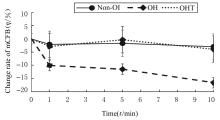| 1 |
VAN CAMPEN C L M C, ROWE P C, VISSER F C. Compression stockings improve cardiac output and cerebral blood flow during tilt testing in myalgic encephalomyelitis/chronic fatigue syndrome (ME/CFS) patients:a randomized crossover trial[J]. Medicina,2021, 58(1): 51.
|
| 2 |
KATSI V, PAPAKONSTANTINOU I, SOLOMOU E,et al. Management of hypertension and blood pressure dysregulation in patients with Parkinson’s disease-a systematic review[J].Curr Hypertens Rep,2021,23(5): 26.
|
| 3 |
MOROI M K, RUZIEH M, AHMED A, et al. Prevention and management of supine hypertension in patients with orthostatic hypotension[J]. Am J Ther, 2021, 28(2): e228-e231.
|
| 4 |
GANNON J, CLAFFEY P, LAIRD E, et al. The cross-sectional association between diabetes and orthostatic hypotension in community-dwelling older people[J].Diabet Med,2020,37(8):1299-1307.
|
| 5 |
MIN M, SHI T T, SUN C Y,et al.The association between orthostatic hypotension and cognition and stroke: a meta-analysis of prospective cohort studies[J]. Blood Press, 2020,29(1):3-12.
|
| 6 |
VAN DIJK J G, VAN ROSSUM I A, THIJS R D,et al. Timing of circulatory and neurological events in syncope[J].Front Cardiovasc Med,2020,7:36.
|
| 7 |
CLAASSEN J A H R, THIJSSEN D H J, PANERAI R B, et al. Regulation of cerebral blood flow in humans: physiology and clinical implications of autoregulation[J].Physiol Rev,2021,101(4):1487-1559.
|
| 8 |
唐玮婷,范文捷,顾 慧,等.直立不耐受患者卧立位TCD脑血流临床分析[J].中国实用神经疾病杂志,2021,24(10):893-898.
|
| 9 |
CASTRO P, FREITAS J, AZEVEDO E, et al. Cerebrovascular regulation in patients with vasovagal syncope and autonomic failure due to familial amyloidotic polyneuropathy[J]. Auton Neurosci,2022,242:103010.
|
| 10 |
APONTE-BECERRA L, NOVAK P. Tilt test: a review[J].J Clin Neurophysiol,2021,38(4):279-286.
|
| 11 |
中国老年保健医学研究会晕厥分会,中国生物医学工程学会心律分会,中国老年学和老年医学学会心血管病专业委员会,等.直立倾斜试验规范应用中国专家共识2022[J].中国循环杂志,2022,37(10):991-1001.
|
| 12 |
RAHMAN M, PRADHAN N, CHEN Z Y, et al. Orthostatic hypertension and intensive Blood pressure control; post-hoc analyses of SPRINT[J].Hypertension,2021,77(1):49-58.
|
| 13 |
GONZÁLEZ-HERMOSILLO J A, RUBIO-VEGA A, GONZÁLEZ-OLVERA K A F, et al. Early cerebral hypoperfusion in patients with orthostatic intolerance without tachycardia during head-up tilt test is independent of vasovagal response[J]. Rev Invest Clin, 2021, 73(6):388-398.
|
| 14 |
中华医学会神经病学分会, 中华医学会神经病学分会脑血管病学组.中国各类主要脑血管病诊断要点2019[J]. 中华神经科杂志, 2019, 52(9): 710-715.
|
| 15 |
JURASCHEK S P, LONGSTRETH W T JR, LOPEZ O L, et al. Orthostatic hypotension, dizziness, neurology outcomes, and death in older adults[J]. Neurology, 2020, 95(14): e1941-e1950.
|
| 16 |
CUI Y, ZHANG H, ZHAO Y X, et al. Home-measured orthostatic hypotension associated with cerebral small vessel disease in a community-based older population[J].Hypertens Res,2020,43(8):798-807.
|
| 17 |
PEI J Y, ZHANG H, LI Y N, et al. Relationship between orthostatic blood pressure changes and intensive blood pressure management in patients with hypertension[J]. Heart,2022,109(2):111-118.
|
| 18 |
BARZKAR F, MYINT P K, KWOK C S, et al. Prevalence of orthostatic hypertension and its association with cerebrovascular diagnoses in patients with suspected TIA and minor stroke[J]. BMC Cardiovasc Disord,2022,22(1):161-169.
|
| 19 |
GERLACH D A, MAIER A, MANUEL J, et al. Real-time magnetic resonance imaging to study orthostatic intolerance mechanisms in human beings: proof of concept[J].J Am Heart Assoc,2022,11(21):e026437.
|
| 20 |
CANAVAN M, O’DONNELL M J. Hypertension and cognitive impairment: a review of mechanisms and key concepts[J].Front Neurol,2022,13:821135.
|
| 21 |
FOSTER-DINGLEY J C, MOONEN J E F, DE RUIJTER W, et al. Orthostatic hypotension in older persons is not associated with cognitive functioning, features of cerebral damage or cerebral blood flow[J]. J Hypertens,2018,36(5):1201-1206.
|
| 22 |
XIA X, WANG R, VETRANO D L, et al. From normal cognition to cognitive impairment and dementia: impact of orthostatic hypotension[J]. Hypertension,2021,78(3):769-778.
|
| 23 |
NOVAK P, GIANNETTI M P, WELLER E, et al. Mast cell disorders are associated with decreased cerebral blood flow and small fiber neuropathy [J].Ann Allergy Asthma Immunol,2022,128(3):299-306.e1.
|
| 24 |
王佳玉,吴越阳,张 佳,等.经颅多普勒超声联合直立倾斜试验对直立性脑低灌注综合征的诊断价值[J].实用心电学杂志,2022,31(5):330-335.
|
| 25 |
JORDAN J, RICCI F, HOFFMANN F,et al. Orthostatic hypertension:critical appraisal of an overlooked condition[J]. Hypertension,2020,75(5):1151-1158.
|
 )
)


